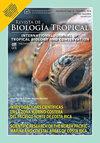东热带太平洋机会珊瑚碎片生长的时空变化:对珊瑚礁恢复的影响
IF 0.6
4区 生物学
Q4 BIOLOGY
引用次数: 0
摘要
简介:珊瑚礁群落被认为是最具生物多样性但也是最受威胁的海洋生态系统之一,过去几十年来栖息地的加速丧失需要积极干预。目的:本研究证明了在墨西哥中部太平洋三个退化珊瑚群落中成功实施了低影响恢复技术,使用了基于分支珊瑚Pocillopora spp.的自然碎片(“机会碎片”)的方案。,被认为是热带太平洋东部最丰富的原生碳酸盐岩珊瑚。方法:在两个近海和一个近海珊瑚礁区实施修复方案。海水温度与珊瑚存活、生长和附着率之间的关系在一年内进行了评估,每月监测183个碎片。结果:珊瑚的平均生长速率为3.3±0.1 mmo-1,年生长速率在长度和宽度上分别为39.9±14.2和36.5±19.5 mmyr-1。自附效率为78%,生存率高(84%)。珊瑚礁的生长速度差异很大。结论:在对直接破碎的珊瑚进行了一年多的监测后,认为生长率足够高,值得在该地区积极恢复。然而,我们的数据表明,在东太平洋区域成功的长期珊瑚群落恢复举措中,必须全面考虑结构和非生物差异以及季节变化。本文章由计算机程序翻译,如有差异,请以英文原文为准。
Spatio-temporal variation in the growth of coral fragments of opportunity in the Eastern Tropical Pacific: implications for coral reef restoration
Introduction: Coral- reef communities are considered one of the most biodiverse, but also most threatened, marine ecosystems, and the accelerating loss of habitat over the past decades warrants active intervention.
Objective: The present study demonstrates the successful implementation of a low-impact restoration technique in three Central Mexican Pacific degraded coral communities, using a protocol based on natural fragmentation (“fragments of opportunity”) of the branching coral Pocillopora spp., considered the most abundant and primary carbonate-producing coral species of the Eastern Tropical Pacific.
Methods: The restoration program was implemented in two offshore and one inshore coraline areas. The relationships between seawater temperature and coral survival, growth, and attachment rate were assessed over one year, with 183 fragments monitored each month.
Results: The mean coral growth rate was 3.3 ± 0.1 mm mo-1, with annual growth rates in length and width of 39.9 ± 14.2 and 36.5 ± 19.5 mm yr-1, respectively. Self-attachment efficiency was 78 % and the survival rate was high (84 %). The growth rate differed significantly among reefs.
Conclusions: Upon monitoring directly fragmented corals over a year, growth rates were deemed high enough to merit active restoration in the region. However, our data show that structural and abiotic differences and seasonal variability must be considered overall in successful long-term coral community restoration initiatives in the eastern Pacific region.
求助全文
通过发布文献求助,成功后即可免费获取论文全文。
去求助
来源期刊

Revista De Biologia Tropical
生物-生物学
CiteScore
1.80
自引率
0.00%
发文量
23
审稿时长
4-8 weeks
期刊介绍:
The Revista de Biología Tropical / International Journal of Tropical Biology and Conservation is a mainstream scientific journal published since 1953 and covered by Web of Science; Science Citation Index; Current Contents; Google Scholar; Scopus, SciELO and nearly 50 additional indices.
A double blind system guarantees you a fair evaluation, and our world class editorial and scientific boards provides a first decision in three working days. The journal is Full Open Access and is widely read where your article can have the highest real impact.
Since its beginning in 1953, the Revista follows these principles: objective and independent evaluation of all manuscripts; transparency in all processes; ethical use of procedures, data, specimens and subjects; fair treatment of all parties; and absolute predominance of scientific rigor over any other aspect.
 求助内容:
求助内容: 应助结果提醒方式:
应助结果提醒方式:


